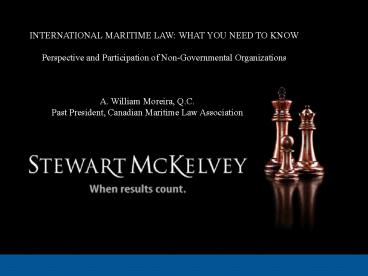INTERNATIONAL MARITIME LAW: WHAT YOU NEED TO KNOW - PowerPoint PPT Presentation
1 / 10
Title:
INTERNATIONAL MARITIME LAW: WHAT YOU NEED TO KNOW
Description:
INTERNATIONAL MARITIME LAW: WHAT YOU NEED TO KNOW Perspective and Participation of Non-Governmental Organizations A. William Moreira, Q.C. Past President, Canadian ... – PowerPoint PPT presentation
Number of Views:1111
Avg rating:3.0/5.0
Title: INTERNATIONAL MARITIME LAW: WHAT YOU NEED TO KNOW
1
INTERNATIONAL MARITIME LAW WHAT YOU NEED TO
KNOW Perspective and Participation of
Non-Governmental Organizations
A. William Moreira, Q.C.Past President, Canadian
Maritime Law Association
2
INTERNATIONAL MARITIME ORGANIZATION
- UN Specialized Agency created 1948, commenced
operations 1959 - Members are 168 Member States
- Specialist Committees include Legal Committee,
created 1968 - 68 NGOs granted Consultative Status at IMO, about
15 actively participate in Legal Committees work - One of the consultative NGOs is Comité Maritime
International (CMI)
3
COMITÉ MARITIME INTERNATIONAL
- Created at Antwerp 1897
- Members are 51 national Maritime Law Associations
- Consultative Members of CMI include two
intergovernmental organizations, IMO and IOPC
Fund - Honourary individual members
- Governed by elected Executive Council, most of
whom are practising maritime lawyers - Headquartered at Antwerp
4
COMITÉ MARITIME INTERNATIONAL (Contd)
- The lawyer should hold the pen the practical
man should dictate the solutions Louis
Franck - At inception, CMI claimed as members
representatives of all aspects of maritime
commerce over time it has become dominated by
lawyers - CMI bases its work on the broadest possible
consensus among the international maritime
community, including industry, the legal
profession, and governments
5
COMITÉ MARITIME INTERNATIONAL (Contd)
- Object
- To contribute by all appropriate means and
activities to the unification of maritime law in
all its aspects - Specific mandate to co-operate with other
international organizations. - Long-standing and close relationship with Legal
Committee since 1969 - Offers private practitioner and commercial
perspectives to an essentially public-policy
driven body - Presently working also with other UN specialized
agencies including UNCITRAL and UNESCO
6
COMITÉ MARITIME INTERNATIONAL (Contd)
- From 1910 to 1969, worked with Belgian government
to produce 22 so-called Brussels Conventions - Examples
- Collision (1910)
- Hague Rules (1924, amended 1968)
- Arrest of Seagoing Ships (1952)
- In addition, CMI remains custodian of
York-Antwerp Rules, purely private instrument
regulating general average
7
COMITÉ MARITIME INTERNATIONAL (Contd)
- Work with IMO Legal Committee
- Commenced with Legal Committees inception 1969
- Participated in preparation of CLC 1969
- Active and continuous participation including
- Fund Convention 1971, and amendments
- Athens Convention on Passengers 1974, and
amendments - Limitation of Liability Convention 1976, and
amendment - Salvage Convention 1989
- Bunkers Convention 2001
- Wreck Removal Convention 2007
8
WRECK REMOVAL CONVENTION 2007
- First considered as part of Torrey Canyon
response in 1969, deferred at that time - Returned later to Legal Committee work program,
led by Netherlands, Germany and UK delegations to
Legal Committee - CMI created International Working Group in 1996,
reported to Legal Committee October 1996. Review
of CMI members national laws governing wreck
removal in the territorial sea - CMI at Legal Committee request produced 2004
analysis of draft Conventions compatibility with
Salvage Convention and other existing
international instruments - CMI assisted with 2007 debate which ultimately
led to opt-in provision regarding Conventions
application in territorial sea
9
COMMENTS ON WRECK REMOVAL CONVENTION 2007
- Follows now-established model in liability
conventions of shipowner strict liability,
compulsory insurance and right of direct action
against insurer, with important unique
exceptions - No stand-alone limitation of amount of liability
- Claimants limited to coastal state public
authorities - Concern with potential lack of uniformity in
coastal state application - Liability provisions are practically engaged upon
coastal state determination that specific wreck
is a hazard - Determination at coastal state discretion, with
insufficient binding guidance provided in the
instrument itself regarding application of the
Article 6 criteria
10
INTERNATIONAL MARITIME LAW WHAT YOU NEED TO
KNOW Perspective and Participation of
Non-Governmental Organizations
Thank you































